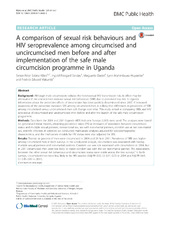| dc.contributor.author | Kibira, Simon Peter | en_US |
| dc.contributor.author | Sandøy, Ingvild Fossgard | en_US |
| dc.contributor.author | Daniel, Marguerite | en_US |
| dc.contributor.author | Atuyambe, Lynn Muhimbuura | en_US |
| dc.contributor.author | Makumbi, Fredrick Edward | en_US |
| dc.date.accessioned | 2018-01-03T07:50:44Z | |
| dc.date.available | 2018-01-03T07:50:44Z | |
| dc.date.issued | 2016-01-05 | |
| dc.identifier.issn | 1471-2458 | |
| dc.identifier.uri | https://hdl.handle.net/1956/17103 | |
| dc.description.abstract | Background: Although male circumcision reduces the heterosexual HIV transmission risk, its effect may be attenuated if circumcised men increase sexual risk behaviours (SRB) due to perceived low risk. In Uganda information about the protective effects of circumcision has been publicly disseminated since 2007. If increased awareness of the protection increases SRB among circumcised men, it is likely that differences in prevalence of SRB among circumcised versus uncircumcised men will change over time. This study aimed at comparing SRBs and HIV sero-status of circumcised and uncircumcised men before and after the launch of the safe male circumcision programme. Methods: Data from the 2004 and 2011 Uganda AIDS Indicator Surveys (UAIS) were used. The analyses were based on generalized linear models, obtaining prevalence ratios (PR) as measures of association between circumcision status and multiple sexual partners, transactional sex, sex with non-marital partners, condom use at last non-marital sex, and HIV infection. In addition we conducted multivariate analyses adjusted for sociodemographic characteristics, and the multivariate models for HIV status were also adjusted for SRB. Results: Twenty six percent of men were circumcised in 2004 and 28 % in 2011. Prevalence of SRB was higher among circumcised men in both surveys. In the unadjusted analysis, circumcision was associated with having multiple sexual partners and non-marital partners. Condom use was not associated with circumcision in 2004, but in 2011 circumcised men were less likely to report condom use with the last non-marital partner. The associations between the other sexual risk behaviours and circumcision status were stable across the two surveys.” In both surveys, circumcised men were less likely to be HIV positive (Adj PR 0.55; CI: 0.41–0.73 in 2004 and Adj PR 0.64; CI: 0.49–0.83 in 2011). Conclusions: There was higher prevalence of SRBs among circumcised men in both surveys, but the only significant change from 2004 to 2011 was a lower prevalence of condom use among the circumcised. Nevertheless, HIV prevalence was lower among circumcised men. Targeted messages for circumcised men and their sexual partners to continue using condoms even after circumcision should be enhanced to avoid risk compensation. | en_US |
| dc.language.iso | eng | eng |
| dc.publisher | BioMed Central | eng |
| dc.relation.ispartof | <a href="http://hdl.handle.net/1956/17107" target="_blank">Male circumcision, sexual risk behaviour and HIV infection in Uganda. A mixed methods study among men age 15-59 years</a> | |
| dc.rights | Attribution CC BY | eng |
| dc.rights.uri | http://creativecommons.org/licenses/by/4.0 | eng |
| dc.subject | Circumcision | eng |
| dc.subject | Condom use | eng |
| dc.subject | Survey | eng |
| dc.subject | Sexual risk behaviours | eng |
| dc.subject | HIV | eng |
| dc.subject | Multiple partners | eng |
| dc.subject | Non-marital sex | eng |
| dc.subject | Uganda | eng |
| dc.title | A comparison of sexual risk behaviours and HIV seroprevalence among circumcised and uncircumcised men before and after implementation of the safe male circumcision programme in Uganda | en_US |
| dc.type | Peer reviewed | |
| dc.type | Journal article | |
| dc.description.version | publishedVersion | en_US |
| dc.rights.holder | Copyright 2017 The Author(s) | |
| dc.source.articlenumber | 7 | |
| dc.identifier.doi | https://doi.org/10.1186/s12889-015-2668-3 | |
| dc.identifier.cristin | 1312401 | |
| dc.source.journal | BMC Public Health | |
| dc.source.40 | 16 | |

